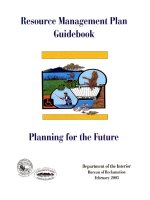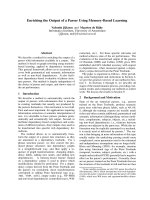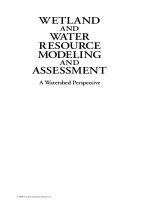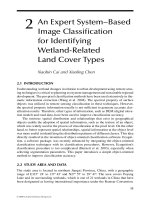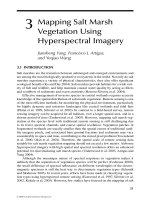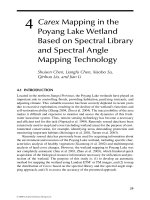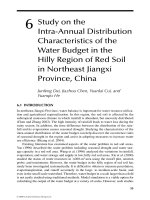Water resource management plan of a micro-watershed using geospatial techniques
Bạn đang xem bản rút gọn của tài liệu. Xem và tải ngay bản đầy đủ của tài liệu tại đây (354.33 KB, 8 trang )
Int.J.Curr.Microbiol.App.Sci (2019) 8(2): 270-277
International Journal of Current Microbiology and Applied Sciences
ISSN: 2319-7706 Volume 8 Number 02 (2019)
Journal homepage:
Original Research Article
/>
Water Resource Management Plan of a Micro-Watershed using
Geospatial Techniques
Madhukar Patel1* and Dhiraj Khalkho2
1
2
Agricultural Engineering, College of Agriculture & Research Station, Raigarh, India
Department of Soil and Water Engineering, SVCAET&RS, FAE, IGKV, Raipur, India
*Corresponding author
ABSTRACT
Keywords
GIS, Remote
sensing, Land use
land cover maps,
Water resource
management
Article Info
Accepted:
04 January 2019
Available Online:
10 February 2019
Geospatial technique were used for land and water management action plan for Dhangaon
micro watershed in Bemetara district, Chhattisgarh. Keeping in view the need of micro
level planning and usefulness of modern tools and technology a study on water resource
planning of water resources for micro watershed was conducted. The objective of the
present research work was to prepare the thematic maps of land use/ land cover, soil, slope
and drainage using satellite imagery data and survey of India (SOI) toposheet of micro
watershed and to integrate all the maps under GIS environment to prepare the water
resource management plans for the study of micro watershed. The study will be helpful in
identification of sites for construction of different soil and water conservation structures
like water harvesting structures, check dams, farm ponds, percolation tanks, nala widening
and deepening of drainage network etc. Different soil and water conservation works are
suggested under water resource action plan with specific sites, locations and maps. The
study will be helpful in sustainable development of the natural resources of the micro
watershed with the proper implementation of the proposed action plans.
programme
successful,
site
specific
management plan has to be generated and
implemented depending on the needs of the
field (Khalkho et al., 2014). Agriculture is the
largest user of the world's freshwater
resources, consuming 70%. Geospatial
technologies such as remote sensing (RS) and
Geographic Information System (GIS) have
been found to be effective tools for
delineating rainwater harvesting potential
zones and selecting sites for rainwater
harvesting structures, and play a vital role in
the planning and management of water
Introduction
Water resource management planning has
regard to all the competing demands for water
and seeks to allocate water on an equitable
basis to satisfy all uses and demands.
Agriculture is the mainstay of the state of
Chhattisgarh. Chhattisgarh’s economy is
predominantly agriculture based. It is the
main occupation of the people. Paddy is the
principal crop and the central plains of
Chhattisgarh are known as rice bowl of
central India. To make any developmental
270
Int.J.Curr.Microbiol.App.Sci (2019) 8(2): 270-277
resources (Jha and Peiffer, 2006). The aim has
been to ensure the availability of drinking
water, fuel wood, and fodder and raise income
and employment for farmers and landless
labourers through improvement in agricultural
production and productivity (Rao, 2000).
headquarter Bemetara, which is well
connected to Jabalpur, Raipur, Bilaspur, Durg
and Kawardha by road network. The nearest
railway station is Tilda railway station under
SECR which is about 40 km from Dhangaon.
The nearest airport is Raipur which is about
77 km from Dhangaon.
Keeping in view the above said importance of
natural resource management plan is to be
developed on micro watershed scale. The
present study was undertaken with a specific
objective of developing site specific waterresources management plan at cadastral/field
level for providing management plan to
individual farmer.
IRS-P6 (LISS-IV) satellite data of 10th
October 2014 (path/row: 102/57) was used in
this study. Survey of India (SOI) toposheet
64-G/9 of 1:50000 was used to prepare base
map of the study area. Various thematic maps
like drainage, water bodies were extended
from base map, field work and ground truth
verification. The cadastral map of the 1:4000
scale was acquired for the Department of
Land Revenue, Government of Chhattisgarh,
for the field level information of the
Dhangaon village. The toposheet and
cadastral map is digitized and georectified.
The database of field level information from
the land records and cadastral map was
generated to give the clear picture about the
land holdings of the inhabitants. ERDAS
IMAGNE 2011 and ArcGIS 10 software were
used for image processing and GIS work.
Pixel based classification was adopted for the
classification of land use/ land cover form the
satellite image. Digitized revenue or cadastral
map was used to delineate each and every
field with the creation of digital database of
the land records.
Materials and Methods
Study area
Dhangaon micro-watershed of Bemetara
block of Bemetara district and located
between 210 49’0”and 210 51’0” N latitudes
and 810 33’30” and 810 35’30” E longitudes
was adopted for the study (Figure 1). It falls
in SOI topographical map no. 64G/9 on scale1: 50,000. The study was carried out in the
department of soil and water engineering,
Faculty of Agril. Engg., Raipur during 20132015. The geographical area of microwatershed was found to be 573.44 ha. The
general elevation of the study area ranges
from 262 m to 278 m above mean sea level
(MSL). The annual average rainfall of the
area is 1140 mm. The predominant soil of
watershed is clay though sandy loam, sandy
clay loam, loam and clay loam were also
found in the watershed. The watershed
receives an average annual rainfall of 1140
mm. The daily mean temperature ranges from
40.0oC to 3.0oC. The daily mean relative
humidity varies from a minimum of 40% in
the month of April to a maximum of 88% in
the month of July. The overall climate of the
area can be classified as sub-tropical.
Dhangaon is situated 10 km from the district
Following
resampling,
geometrically
corrected near-infrared, red and green band of
the LISS IV data was used to generate a false
color composite (FCC) of the study area.
Supervised classification was used to identify
the various land cover pattern of the area and
delineation of water bodies. Data obtained by
ground truthing using GPS (Global
Positioning system) were used for pixel based
image classification. Various thematic maps
were generated like soil texture, land use, land
cover, drainage network and DEM. Grid
271
Int.J.Curr.Microbiol.App.Sci (2019) 8(2): 270-277
based soil sampling was done to get
representative of the four farming situations
for analyzing the profile of the study area.
The soil sampling of the village was analyzed
for giving the field condition of Microwatershed in perspective of the farming
situation and fertility. Different variety of
crops were suggested based on the farming
situation, land use and land cover. The
methodology adopted for the study is
presented in the form of flow chart in Figure
2.
order stream were found at Dhangaon microwatershed with 4.14 km and 3.3 km length
respectively. The total length of the stream
found was to be 7.17 km. In Dhangaon micro
watershed, Hamp River flows from its
Northern boundary which affects mostly the
drainage pattern in the micro watershed. The
drainage density was found to be 1.28
km/km2 (Figure 3). The low value of drainage
density reflects the dominations of over all
flow in the study area.
Land use/ land cover
Results and Discussion
Based on the pixel based classification and
image characteristics eight land use classes
(Figure 4) were identified in the watershed
with major part of the study area dominated
by paddy crop (199.37 ha) which is 33% of
the total area. This is followed by Soybean
(124.07 ha), which is 21.54% current fallow
(113.08 ha) which is 19.64% of the total area
pigeon pea (54.439 ha) which is 9.45% of the
total area. Deep water body contributes 2.15%
of the total area and small water body by
0.015% of the total area.
Topography
The topography of the present micro
watershed area is gentle to undulating. Major
soil types found in the micro-watershed are;
Entisols (Sandy loam) Inceptisols (Sandy clay
loam) Alfisol (Loam) Vertisols (Clay). Lands
are fertile having moisture retention capacity
with monsoonic rain and good vegetation.
Agriculture lands in the area are productive
but some where it is unproductive due to
biotic-interference and soil erosion. Paddy is
the dominant agriculture crop along with
soybean and pigeon pea in kharif and
followed by chickpea, wheat etc.
Soils
The soil texture of the Dhangaon Microwatershed (Figure 5) varies from sandy loam
to clay. Four classes of soil texture were
identified with Inceptisols (sandy clay loam)
contribute 309.84 ha, which is 60.86% of the
total area followed by Alfisol covering
161.826 ha, along with vertisols and Entisols
covering (72.69 ha) and (46.74 ha)
respectively. Soil erosion depends much on
the infiltration rate of a soil.
Drainage Map
Drainage map comprises of various streams
that are flowing in the area. Drainage patterns
and textures are dissection signatures and
very important terrain recognition elements,
used as criteria for identification of geological
and geomorphological phenomena. In this
pattern, the smallest finger-type tributaries are
designated order1; where two first order
channels join, a channel segment of order 2 is
formed; where two channels of order 2 join, a
segment of order 3 is formed and so forth.
This happens due to the land slope pattern and
also the characteristics of soil. 1st and 2nd
The infiltration rate depends on the soil
texture as in sandy soil the infiltration rate is
higher than silty soil. In a clayey soil it may
be initially high (for heavy black clay with
cracking), but becomes low when the soil is
moist to wet. Soil Health is a state of a soil
272
Int.J.Curr.Microbiol.App.Sci (2019) 8(2): 270-277
meeting its range of ecosystem function as
appropriate to its environment. A soil analysis
is a process by which elements such as P, K,
Ca, Mg, Na, S, Mn, Cu and Zn are chemically
extracted from the soil and measured for their
“plant available” content within the soil
sample.
870ft, 871 to 871-885ft, 886 to 897 ft and 898
to 913ft respectively.
Water resources development plan
The water resource development plan of
Dhangaon micro watersheds was prepared by
overlaying land use/land cover map, slope
map, soil map and drainage map using ArcGIS software packages in GIS, respectively.
The water resources management plan is
generated to make the judicious and effective
use of water resources of the micro watershed
to enhance the productivity and mitigate
drought. The plan indicates sites for surface
water
development
and
groundwater
exploitation.
DEM
Digital Elevation Model (DEM) was
generated (Figure 6) using the contour map
along with the field surveys and done using
global positioning system (GPS). The
elevation of the project area was found to be
in the range of 534-661 m above mean sea
level. The DEM was generated by the
classifying the relief in four class. Viz. 851to
Table.1 Water availability in the micro watershed
in Mm3
6.50
1.63
2.70
0.24
1.26
Rainfall volume
Runoff volume
Crop requirement
Released through tank
Net ground water available
Table.2 Crop water requirement
Farming
Situation
Bhata
Matasi
Dorsa
Total
Area under current
fallow (ha)
12
60
40
112
Proposed Crop
Pigeon Pea
Soybean
Paddy
Water requirement
(mm)
0.30
0.65
0.90
1.85
Table.3 Proposed structures for water harvesting in the micro watershed
Sl. No.
1.
2.
3.
Type of Structures
Check Dam
Farm Pond
Percolation Tank
273
Quantity
3
3
3
Mm3
0.03
0.39
0.36
0.78
Int.J.Curr.Microbiol.App.Sci (2019) 8(2): 270-277
Fig.1 Location of the study area
Fig.2 Layout showing the methodology of the study
IRS P6 MX LISS IV
Toposheets (1:50000
scale)
Base map Preparation
Field work
ground truthing
Georeferencing,
Digitization & Editing of
cadastral map
Pixel based classification of
land use land cover
Generation of various
thematic map
Creating digital
database for map and
attribute data
Generation of composite
map with farming situation
Water resource development
plan
274
Revenue map
(1:4000)
Int.J.Curr.Microbiol.App.Sci (2019) 8(2): 270-277
Fig.3&4 Drainage map of the study area and land use classification of the study
Fig.5&6 Soil texture map of study area and digital elevation model of study area
Fig.7 Water resource plan
275
Int.J.Curr.Microbiol.App.Sci (2019) 8(2): 270-277
Different engineering structures are proposed
for the water resource development and are
depicted in Figure 7. The planning for water
resource reflects the approach for the use of the
resources in a careful manner for sustainable
development of the micro watershed.
In conclusion, as per different soil health status,
DEM, and drainage network different variety of
crops as well as different water harvesting
structure viz. Percolation tank (3 nos), Check
dam (3 nos), and Farm ponds (3 nos) are
proposed/suggested at appropriate locations,
and water management plan was developed at
field level specifying the use of all the revenue
field based on the availability of natural
resources and its potential.
The present water availability in the micro
watershed is presented in Table 1.
Conservation, management and development of
water resources form integral component of the
development plan. As per the proposed land use
plan, 112 ha of current fallow under different
farming situations can be brought to cultivation
with the available water resources as presented
in Table 2.
Cadastral level land and water resource
development plan was generated using
geospatial techniques which enable us to
accesses large volume of information for
analysis to develop plan and implement
appropriate package of practices as per the
potential of the fields. The attribute of the
developed geodatabase enable us to search any
field by its cadastral/revenue as khasra number
or by its owner’s name. This user friendly and
handy tool of information will definitely help in
increase of the adoption of scientific planning
by the farmers and the developmental agencies.
Suitable structures are suggested for surface
water harvesting and ground water recharge.
Proposing different soil and water harvesting
structures plays a very crucial role, which
requires a well-qualified and well-experienced
work force with thorough knowledge in various
water conservation programmes. For this
purpose the following thematic layers like
slope, flow direction and flow accumulation
output raster maps along with drainage, land
use/land cover, hydro geomorphology are used.
The water resources management plan was
generated to make the judicious and effective
use of water resources of the watershed to
enhance the productivity and mitigate drought.
The plan indicates the sites for surface water
development and sites for groundwater
exploitation. Percolation tank were proposed on
the upland situations (Bhata and Matasi farming
situations) with emphasis on those area with
high tube well density supported by slope map.
The percolation tank will help in recharge of the
ground water table and will support the farmers
with ground water exploration using tube wells.
Check dam and Farm ponds were proposed
based on the slope and land use/ cover condition
to provide additional water resources for the
cropped land to be brought under cultivation.
Different structures proposed for the water
resource development are given in Table 3 and
in Figure 7.
References
Gao, Z., Gao, W. and Chang, N.B. 2010. Impact
of climate change and land use/land cover
changes on the carbon cycle in china
1981-2000: A system based assessment.
Biogeosci. Discuss., 7:5517-5555.
Hiese, N., Mich, N., Yanthan, M., Yeptho, H.,
Moatoshi, Lotha, R., Pienyü, K.,
Suokhrie, S., Murry, B. and Mor, S. 2011.
Application of Geoinformatics in Land
Resource Management at
MicroWatershed
level
for
sustainable
development of Sanis, Wokha District,
Nagaland. Dimension and direction of
geospatial industry. Geospatial world
forum 18-21, January Hyderabad.
Khalkho, D., Patil, S.K., Patel, S., G.P., Pali,
2013. Cadastral level Mapping for
Efficient Natural Resources Management
of Turenar cluster villages using Remote
Sensing and GIS Technologies. J. Agric.
Issues 18(1&2), 55-60.
Kumar, B., Kumar, U. 2011. Micro watershed
276
Int.J.Curr.Microbiol.App.Sci (2019) 8(2): 270-277
characterization and prioritization using
Geomatics technology for natural
resources Management international J. of
geomatics and geosciences 1(4): 789-802.
Manchanda, M.L., Kudrat, M., Tiwari, A.K.,
2002.Soil survey and mapping using
remote sensing. Tropical Ecology 43, 6174.
Mangrule, V. N. and Kahalekar U. J., (2013)
Watershed Planning and Development
Plan by Using Rs and GIS of Khultabad
Taluka
of
Aurangabad
District.
International Journal of Information and
Computation Technology. 3(10): 10931100.
Patil, G.B., Nargaraju, M.S.S., Prasad, J.,
Shrivastava, R., 2010. Characterization,
evaluation and mapping of landresources
in Lendi watershed, Chadrapur district of
Maharastra using Remote Sensing and
GIS. Journal of Indian Society of Soil
Science 58, 442-448.
Patil, S.S., Nargaraju, M.S.S., Prasad, J.,
Shrivastava, R., 2010. Characterization
and evaluation of land resources of
basaltic
terrain
for
watershed
management using remote sensing and
GIS. Indian Journal of Soil Conservation
38, 16-23.
Praveen, G.S., Babu, B. M., Sarangamath, S. B.
and Balakrishnan, P. 2013. Action plan
for efficient land and water use in a miniwatershed near Mysore using remote
sensing and GIS. International Journal of
Agricultural Engineering, 6(2): 514-518.
Rout, J. and Ojha, A. 2012. Microwatershed
management using RS and GIS
technologies. Published in Geospatial
world, March 2012.
Raghvendran, S. 2002. Cadastral mapping and
land information system, Geospatial
application paper.
S. P. Wani, P. Pathak, H.M. Tam, A.
Ramakrishna, P. Singh and T. K.
Sreedevi, 2002 “Integrated watershed
management for minimizing land
degradation and sustaining productivity in
Asia”, Proceeding of a Joint UNUCAS
International Workshop, 8-13 September
2001, Beijing, China, 2002.
Shukla, A.E., Prasad, J., Nargaraju, M.S.S.,
Shrivastava, R., Kauraw, D.L., 2009. Use
of remote sensing in characterization and
management of Dhamni micro watershed
of Chandrapur district of Maharastra.
Journal of the Indian Society of Remote
Sensing 37, 129-137.
Shrivastava, R., Saxena, R.K., 2004. Technique
of large scale soil mapping using satellite
remote sensing. International Journal of
Remote Sensing 25, 679-688.
Velmurugan, V., Carlos, G.G., 2009.Soil
resource assessment and mapping using
remote sensing and GIS. Journal of the
Indian Society of Remote Sensing 37,
511-525.
How to cite this article:
Madhukar Patel and Dhiraj Khalkho. 2019. Water Resource Management Plan of a MicroWatershed using Geospatial Techniques. Int.J.Curr.Microbiol.App.Sci. 8(02): 270-277.
doi: />
277

